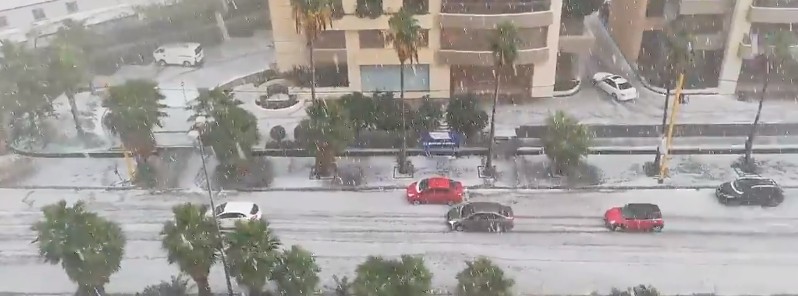Historic hailstorm hits Beirut, Lebanon

A massive hailstorm accompanied by exceptionally heavy rain and drastic temperature drop hit Lebanon's capital Beirut on December 5, 2020, causing massive floods and traffic chaos. The last time Beirut witnessed a similar event was back in 1968.
The hailstorm lasted about 1 hour and was described by meteorologists as historic.
"This supercell affected only the coastal area around Beirut and its suburbs. A supercell effect is always local. Weather stations in Beirut recorded 50 mm [1.96 inches] of rainfall in a lapse of 25 minutes," Elias Saadeh, founder of Lebanon Weather Forecast, told Al Arabiya English.
"This quantity is considered enormous since it is equivalent to pouring 50 liters of water in each square meter [13 gallons per 10 feet2] in 25 minutes. Moreover, this supercell caused a drastic drop in temperature from 21 to 13.5 °C [69.8 – 55.4 °F] in a couple of minutes," Saadeh said.
My joy at seeing this much hail in Beirut for the first time in ages lasted but a few minutes; and then I thought of all those who are still without doors, or even homes, during such weather.
May they be safe and warm and may those who deprived them the joys of winter suffer. pic.twitter.com/JSoiTONRiX
— Talala (@Tala5La) December 5, 2020
— Mustapha Hamoui (@Beirutspring) December 5, 2020
Watch: Residents of Lebanon's #Beirut are using 4-wheel drive vehicle to help retrieve cars that are stuck after the city experienced a historical #hailstorm. https://t.co/S9PkANHkIc pic.twitter.com/IhoLXcldTF
— Al Arabiya English (@AlArabiya_Eng) December 5, 2020
#Beirut today#hailstorm pic.twitter.com/5ni7HJSwQC
— H.K (@Ibra_Joudeh) December 5, 2020
The supercell formed because of favorable environmental atmospheric conditions, including but not limited to the variation in temperature between the sea surface temperature and the temperature in the upper levels of the atmosphere, Saadeh said, adding that the updraft speed might have reached around 30 meters per second, explaining the size of hailstones recorded.
Saadeh elaborated that historically, and according to available captures of the previous severe hailstorms, the last time Beirut witnessed a similar event was in the year 1968.
According to Lebanon Weather Forecast, similar events with hail accumulations all over the capital took place in 1920, 1943, 1963, and 1968.



Featured image credit: Talala

Commenting rules and guidelines
We value the thoughts and opinions of our readers and welcome healthy discussions on our website. In order to maintain a respectful and positive community, we ask that all commenters follow these rules:
We reserve the right to remove any comments that violate these rules. By commenting on our website, you agree to abide by these guidelines. Thank you for helping to create a positive and welcoming environment for all.